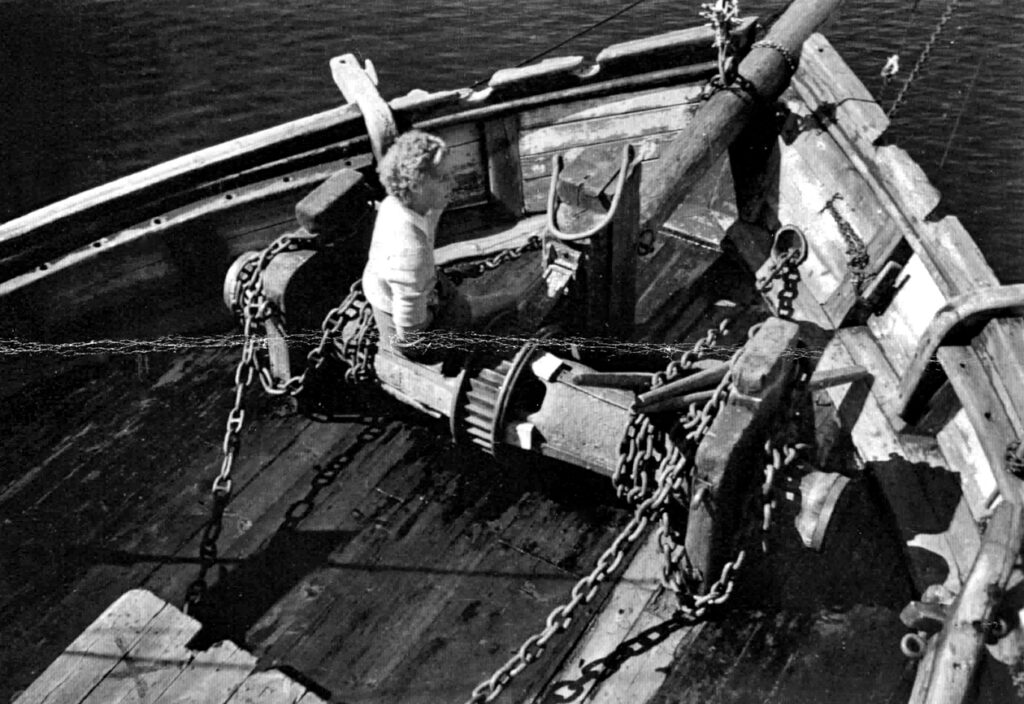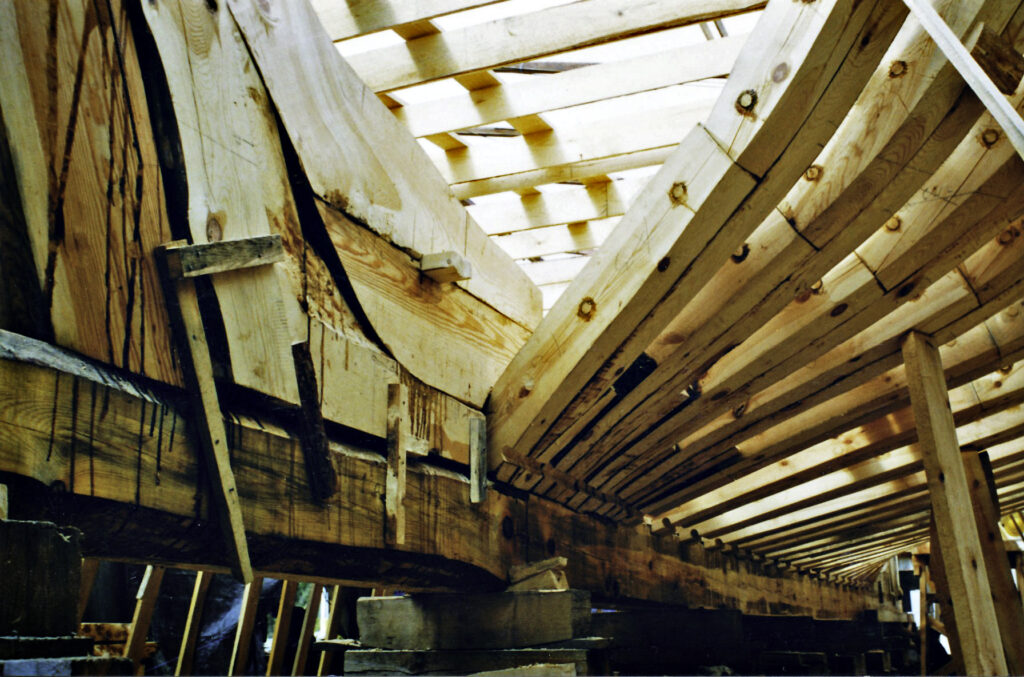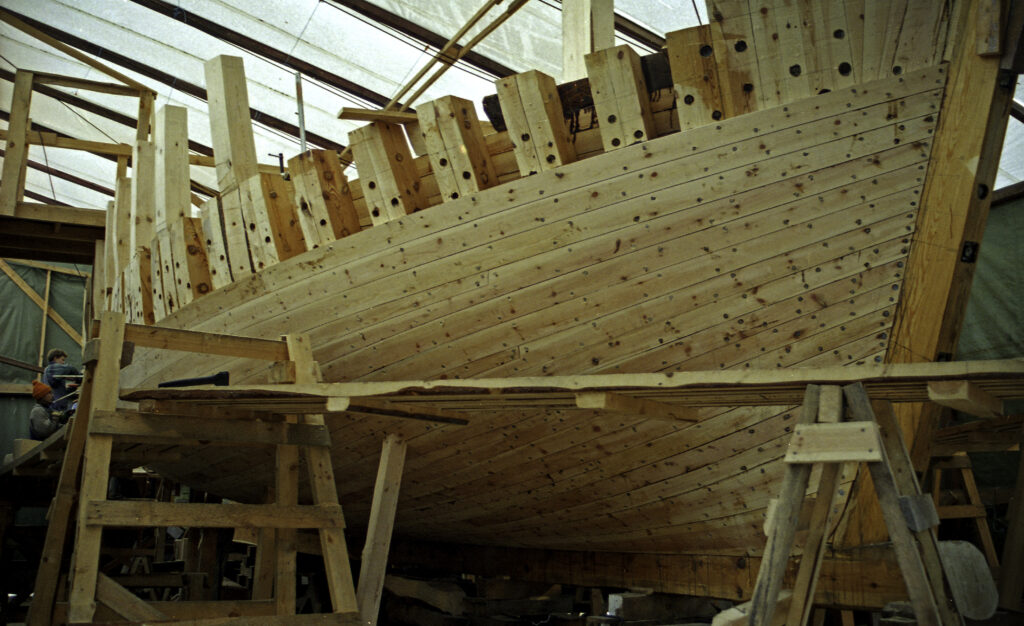BACKGROUND AND HISTORY
Original ship
Eugenia is a replica of a yacht with the same name, which was built in 1879 in Bolax, Hitis. She sailed until 1951, when she sank by Remörarna in Hitis, where she was anchored. The skipper was old and home with an illness and was unable to save her. The following decades, the hull was damaged by the ice and many removable things were collected by recreational divers.
The wreck lies at a depth of 4–6 meters by Remörarna, Hitis. Only a few broken parts of the frame protrude from the bottom mud — the galley, the steering wheel and the gun wales are gone.
Eugenia is mentioned in several books, among them “Vinden bar hem” (Allan Gustafsson, 1976). She was a typical yacht for her time and place, except for the fact that she never had an engine installed. “There will never be an engine in Eugenia. Someone needs to be a sailor as well!”, her skipper and owner “Storö-Oskar” a.k.a. Oskar Gustafsson is said to have exclaimed when the engineers in Dalsbruk suggested the installation of an engine. When she was removed from the ship register of the Finnish maritime administration in 1953, only two sailing ships remained: the galeas Frida from Åland and the schooner Linden (of which a replica was built during 1990–1993 in Mariehamn).

Eugenia was built during 1879–1880 by Gustaf Andersson, the father of Storö-Oskar. The project was led by shipwright A. Grundström. In 1905, major reconstruction was done. It was probably at this time that the hull was changed to use carvel planking. The ship was also reinforced as she specialized in heavy stone freights. The largest stone is said to have weighed 13.5 tons. She was rated for a maximum of 45 tons of cargo but did occasionally sail with up to 49.5 tons. Among other projects, Eugenia brought sand and stone to the building site of the Bengtskär lighthouse during 1905–1906.
It is likely that hemp was originally used for the rigging, but around the turn of the century, it was probably substituted for the more low-maintenance wire rope rigging. The sails were made from hemp until the end. She had a mainsail, main-top and three headsails, even though yachts at this time usually had only two headsails — the two-masted galeases had three headsails.

Eugenia did most of her sailing inside the area bound by Raumo to the north, Mariehamn to the west and Helsinki to the east. Ballast was never used; instead, care was taken to decrease the sail area of the tall rigging in good time. As the ship had no engine, it often had to traverse narrow straits through beating. The anchor was prepared and sometimes had to be lowered when she did not tack fast enough. When possible, the hull was caulked with anthills collected on nearby islands. Apparently, this was not enough. One of the interviewees, Kurt Nykvist from Hangö who sailed on Eugenia during 1940–1943, said he had pumped all the Baltic Sea through her — at least twice!
Replica of Eugenia
The Eugenia project started in January 1997. A group of enthusiasts connected to the Sagalund Museum in Kimito decided to suggest the idea to the inhabitants of Kimitoön. In February, a general meeting was called in the library attic in Västanfjärd. The association Pro Kimitö-Skutan rf was founded and immediately received sixty members, and the message was clear: start building!
The strategy put together during the first meetings was ambitious but later turned out to be correct. Construction was to start the incoming fall. Now, it was necessary to acquire lumber, which had to be felled before the March equinox. The important task of securing financing began as well, and a person was hired for this purpose.
Jan-Erik Enestam, minister and resident of Västanfjärd, promised to function as the patron of the Eugenia project.
During the summer of 1997, the plans were developed further. Bertil Bonns, well-known in ship-building circles, joined the project. For the role of shipwright, a local specialist was chosen: Erik Österberg, an engineer educated in shipbuilding and with over 20 years of experience constructing wooden boats.

On September 6 in 1997, the keel laying took place next to the Sagalund Museum. After this, construction of the frame commenced. This went on until the summer of 1998. In addition to the shipwright, carpenter Igge Scharin and around twenty students participated.
Work on the strakes and the difficult stern came next, led by Max Lassén (builder of, among others, Jacobstads Wapen). In the fall of 1998, this was finished, and the deck beams were added, eventually followed by the deck.

On February 19, Eugenia was moved closer to the sea, to Västanfjärd. The move went well, and Eugenia was put on a new berth, only a few meters from the shore.
In the summer, work on the hull was finished. On July 24, a new highlight occurred: the launching of the ship. Close to 4,000 spectators lined the shores around Lammalaviken in Västanfjärd. Karin Fredriksson, who was the daughter of the last skipper of the original Eugenia and had sailed on Eugenia herself, got to break the bottle of champagne over the bow as the ship’s godmother. An hour later the ship majestically glided into the water, at first slowly, then faster and faster. After this, celebrations followed.

During the winter 1999–2000, the rigging was constructed. A group of sail makers met twice a week to sew the 260 square meters of sails for Eugenia.
Allan Palmer from Mariehamn participated in the rigging work during the spring of 2000. A large part of this was done as communal work. Tor Sjölund and Tapio Heino, retired sailors, contributed greatly to the work. During various stages of construction, Eyvind Still from Jakobstad was consulted as well.
The engines (2 Sisu diesel engines producing 85 horse-powers), axles and propellers were installed by Svante Stenström during summer.
On June 4 in 2000, almost two weeks early, Eugenia was completed. The first season succeeded above expectations as well. The ship sailed almost 4,000 nautical miles and the members of the association (by then already numbering 290) are proud of and happy for the successful project!
Text: Johan Stenbäck
Källor:
Jan-Erik Börman, Åboländsk Bygdeseglation, 1979
Allan Gustafsson: Article in Finlands Sjöfart 1954: Sista seglande jakten dör sotdöden
Allan Gustafsson: Åboländsk bygdesjöfart under segel, Vinden bar hem, 1976
Interview with Miss Karin Fredriksson, daughter of the skipper of the original Eugenia
Interview with chief mate and marine painter Uno Rosenberg, Wenoxa
Interview with Kurt Nykvist, Hangö
More information can be found in Swedish in the book EUGENIA “Någon måste kunna segla också”.
The book is available for purchase in the Sagalund Museum shop, on board the Yacht Eugenia or by ordering via email: info@eugenia.fi
PRICE: 15 € (inkl. VAT 14%)